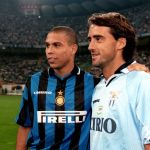
When Umbro was on the top of the game
The collaboration with Supreme certifies the heritage of a brand that still continues to fascinate soccer and fashion fans
February 16th, 2022
In these days Supreme has announced that in its next season will also put on sale sweatshirts and footballs in collaboration with Umbro. It is certainly not the first time that a streetwear brand places on the market a series of football-related items, but with Umbro, the brand of New York promises to rediscover a piece of history of European sportswear. Which means a lot for the history of soccer.
In fact, once limited to your parents' old soccer jerseys or old bar sports, today Umbro jerseys and jackets with the two horizontal diamonds are back in fashion, enhanced by a recurring fetish for the nineties aesthetic resulting not only from the nostalgia effect in the world of soccer, but also for a sentiment of contemporary sportswear that loves to dialogue with those canons. The return of Umbro, which now sponsors West Ham, Brentford, Derby County, Schalke 04 and the Irish national team, is parallel to the re-emerging passion for brands that have never been forgotten but have certainly faded, such as Kappa or Ellesse. Only Umbro, in soccer, has always been a step above everyone.
From the 1980s to the early 2000s, in fact, the best clubs in Europe (and the national teams around the world), those who today wear Nike or adidas, had the English brand as a technical partner. Founded in 1924 by brothers Harold and Wallace Humphrey, its name comes from the union of surname and name of the two brothers, Humphrey's Um and brothers' Bro. Then a history divided between soccer and rugby, a sport that today has boasted most of the teams with the trademark of the two rhombuses.
The Humphrey brothers began working in soccer first and then in rugby and, in the 1930s, they opened up to the general public with their first sponsorship for Manchester City. They will produce, in the following twenty years, on the occasion of the World Wars also military uniforms for soldiers, using for camouflage outfits the same factories engaged for the balls and jackets that in those years dressed the players of Blackpool, Manchester United, Tottenham. In 1958, a scream that goes down in history, when Brazil wins its first world title with the Umbro jersey.
Between the sixties and the nineties Umbro is the brand of soccer. Ajax, Manchester United and City, Chelsea, Arsenal, Aston Villa, and in Italy Inter, Fiorentina, Parma, Napoli, Lazio: all clubs that have dressed the design of Umbro. A phenomenon that was so widespread that even the most minor provincial realities were branded with the English brand. Two examples. Ancona, in '96 in Serie B, and also Cagliari during the same years.
In Italy, Umbro's fortune is linked above all to two realities, Inter and Lazio. Not only because the two clubs won important trophies with the brand on their shirts - the UEFA Cup and the Coppa Italia, respectively - but also because the best stylistic features of the brand's aesthetics were combined in those patterns. Beyond the oversizing that was normal for those times, the various strong points were the buttoned collar and the templates printed on the uniforms. In the first case, the example brings it very well some outfits of Inter with the sponsor Fiorucci. Thin, horizontal Nerazzurri stripes, with a slabbed collar and the club's logo sewn into the center of the chest. In the second, Lazio at the end of 2000, with two main examples: the sky-blue gash on a blue background of the 1994-96 away kit and the grey melange pattern of the third jersey of that season (blue collar and biancocelesti stripes, while the template looks like a cubist fantasy with the Banca di Roma sponsor in the middle).
Inter and Lazio best define Umbro's relationship in Italy. In May 1998, the two teams faced each other in Paris in the final of the UEFA Super Cup, both wearing the English brand's logo. The result rewarded Inter thanks to one of Ronaldo's most iconic technical gestures, the double pass to Marchegiani.
But England, as you can tell from the brand's biography, is the true center for the Humphrey brothers' company, and in particular, the Manchester area. The association with City is historic, much denser than the one with United, since the citizens dressed Umbro from '75 to '97 and then resumed it in more recent times from 2009 to 2013. While in the other half of the city, the Red Devils have been seduced by the popularity of Nike before the cousins citizens, but even they will go through their most winning moment with kits signed Umbro, such as when they won the Champions League at the last breath with that goal of Solskjaer against Bayern Munich. The total red outfit seen in the Barcelona final, however, is not the English brand's best uniform. In fact, Manchester United's 20-year history with Umbro has featured not so much memorable red uniforms, but many other away and training shirts - always maintaining the cardinal points of the brand's aesthetic. White collar, trim on the neckline, rhombuses and various geometric figures printed in relief on the jersey pattern with experimental and unusual colors.
Umbro in the nineties had focused its templates on color projections in brick style, with a lot of gray, purple, colorful sparks with bright shades that in those years were the preferred aesthetic code. The Umbro uniforms, from the second of Ajax to that of Gullit's Chelsea, were proposed with iconographies that were on the one hand cubist and on the other futuristic, like those that appeared in the television commercials of the mid-nineties. Those fantasies have continued throughout the nineties defining the style on the field yesterday and off the field today, continuing to enchant both nostalgic and hypebeast. And now that even Supreme has succumbed to the allure of the double rhombus, everyone is running to fish out the jerseys in the basement.









































.png)


.jpg)







































